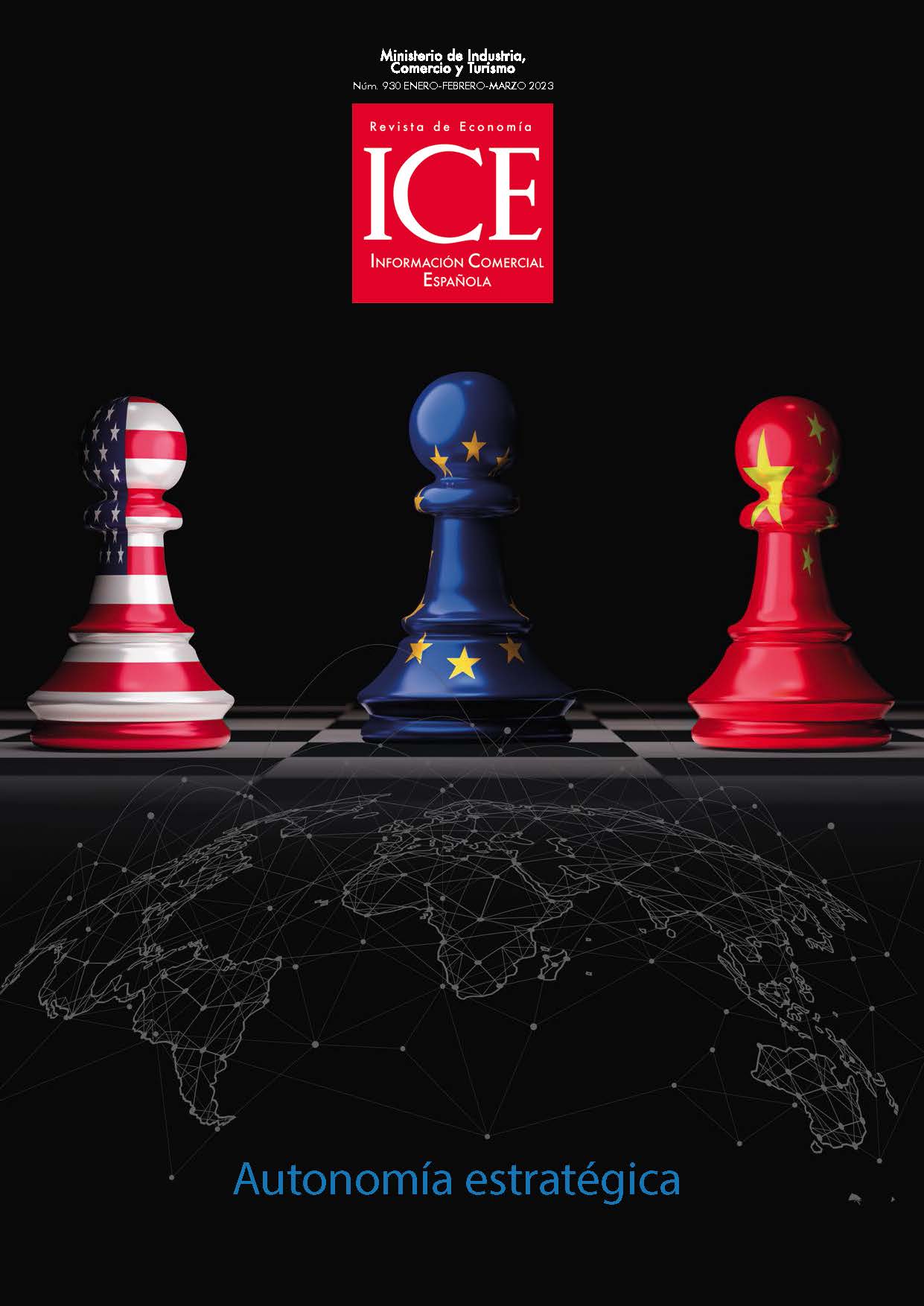Soberanía tecnológica: visión geopolítica desde la Unión Europea
##plugins.themes.bootstrap3.article.sidebar##
Descargas
##plugins.themes.bootstrap3.article.main##
El artículo aborda el concepto de soberanía tecnológica, enmarcado en el de autonomía estratégica, focalizado en la política industrial. Tras definir y establecer la relación entre ambos se presentan los instrumentos de poder blando y poder duro que pueden estar al alcance de la UE para mejorar su soberanía tecnológica, prestando atención a la combinación inteligente de varios de ellos. Tras justificar la necesidad de disponer de un «Índice de Soberanía Tecnológica» para monitorizar las acciones sobre una base cuantitativa, se analiza la relación entre la soberanía digital con la energética, militar, industrial y digital, así como la batalla por el talento tecnológico. Finalmente, se comentan algunas opciones sobre la contribución de España en el contexto de la soberanía tecnológica europea.
##plugins.themes.bootstrap3.article.details##
Borrell, J. (2022). Staying on course in troubled waters. EU foreign policy in 2021. European Union External Action. ISBN 978 92-9463-089-6.
Boullenois, C. (2021). China's Data Strategy: Creating a state-led market. European Union Institute for Security Studies (EUISS). October 6.
Bradford, A. (2020). The Brussels Effect. How the European Union Rules the World. Oxford University Press. ISBN-13: 9780190088583.
Burwell, F. G., & Propp, K. (2022). Digital Sovereignty in Practice: The EU’s Push to Shape the New Global Economy. Atlantic Council. Europe Center. October. ISBN-13: 978-1-61977-254-0.
Csernatoni, R. (2021a). The EU’s Defense Ambitions: Understanding the Emergence of a European Defense Technological and Industrial Complex. December. Carnegie Europe Endowment for International Peace. https://carnegieendowment.org/files/Csernatoni_EU_Defense_v2.pdf
Csernatoni, R. (2021b). The EU’s Rise as a Defense Technological Power: From Strategic Autonomy to Technological Sovereignty. Carnegie Europe. August. https://carnegieeurope.eu/2021/08/12/eu-s-rise-as-defense-technological-power-from-strategic-autonomy-to-technological-sovereignty-pub-85134
Da Ponte, A., León, G., & Álvarez, I. (2022). Technological sovereignty of the EU in advanced 5G mobile communications: An empirical approach. Telecommunications Policy, 47(7), 102459. October. https://doi.org/10.1016/j.telpol.2022.102459
Dupré, B. (2022). European sovereignty, strategic autonomy, Europe as a power: what reality for the European Union and for what future? European Issue No. 620. Fondation Robert Schuman. January 24. https://www.robert-schuman.eu/en/european-issues/0620-european-sovereignty-strategic-autonomy-europe-as-a-power-what-reality-for-the-european-union
Edler, J., Blind, K., Kroll, H., Schubert, T. (2021). Technology Sovereignty as an Emerging Frame for Innovation Policy- Defining Rationales, Ends and Means (Fraunhofer ISI Discussion Papers Innovation Systems and Policy Analysis No. 70). Karlsruhe. July.
EIS. (2022). European Innovation Scoreboard. September. https://research-and-innovation.ec.europa.eu/statistics/performance-indicators/european-innovation-scoreboard_en#european-innovation-scoreboard-2022
European Commission. (2020). A New Industrial Strategy for Europe. Communication from the Commission. COM(2020) 102 final.
European Commission. (2021a). Updating the 2020 New Industrial Strategy: Building a stronger Single Market for Europe’s recovery. Communication from the Commission. COM(2021) 350 final.
European Commission. (2021b). Laying Down Harmonised Rules on Artificial Intelligence (Artificial Intelligence Act) And Amending Certain Union Legislative Acts. COM(2021) 206 final. Brussels, 21.4.2021.
European Commission. (2022a). A Chips Act for Europe. Communication from the Commission. COM(2022) 45 final. February.
European Commission. (2022b). EU strategic dependencies and capacities: second stage of in-depth reviews. SWD(2022) 41 final. Commission Staff Working Document. Brussels, 22.2.2022.
European Commission. (2022c). A New European Innovation Agenda. Communication from the Commission to the European Parliament, the Council, the European Economic and Social Committee and the Committee of the Regions. COM(2022) 332 final. Brussels, 5.7.2022.
Eurostat. (2022, August). Industrial production statistics. Eurostat statistics explained. https://ec.europa.eu/eurostat/statistics-explained/index.php?title=Industrial_production_statistics#:~:text=The%20latest%20data%20from%20Eurostat,in%202021%20compared%20with%202020.&text=In%20nominal%20terms%2C%20the%20EU's,2021%2C%20by%20almost%2014%20%25
Fiott, D. (Ed.). (2021). European Sovereignty. Strategy and interdependence. European Union Institute for Security Studies (EUISS). Chaillot Paper No. 169. July. https://doi.org/10.2815/231962 o https://www.iss.europa.eu/sites/default/files/EUISSFiles/CP_169.pdf
Gray, J. E. (2021). The geopolitics of ‘platforms’: the TikTok challenge. Internet Policy Review, 10(2). https://doi.org/10.14763/2021.2.1557
León, G. (2020). Repercusiones estratégicas del desarrollo tecnológico. Impacto de las tecnologías emergentes en el posicionamiento estratégico de los países. Cuadernos de Estrategia, 207. Instituto Español de Estudios Estratégicos. Ministerio de Defensa.
León, G. y da Ponte, A. (2022). Soberanía tecnológica y poder inteligente de la Unión Europea en un contexto geopolítico inestable: el escenario de África como ejemplo de aplicación. Revista del Instituto Español de Estudios Estratégicos, 18, 365-394.
Negreiro, M. (2022). The NIS2 Directive. A high-common level of cybersecurity in the Union. European Parliamentary Research Service. PE 689.333. June. https://www.europarl.europa.eu/thinktank/en/document/EPRS_BRI(2021)689333
Nye, J. S. Jr. (2005). Soft Power: The Means to Success in World Politics. Public Affairs.
Nye, J. S. Jr. (2009). Get Smart: Combining Hard and Soft Power. Foreign Affairs, 88(4), 160-163.
Poitiers, N., & Weil, P. (2022, January 26). Opaque and ill-defined: the problems with Europe’s IPCEI subsidy framework. Bruegel Blog. https://www.bruegel.org/blog-post/opaque-and-ill-defined-problems-europes-ipcei-subsidy-framework
Renda, A. (2021). The EU Industrial Strategy: Towards a Post-Growth Agenda? Intereconomics, 56(3), 133-138. https://doi.org/10.1007/s10272-021-0968-7
Repnikova, M. (2022). The balance of soft power: the American and Chinese quests to win hearts and minds. Foreign Affairs, 101, 44.
Ringhof, J., & Torreblanca, J. I. (2022). The Geopolitics of Technology: How the EU Can Become a Global Player. Policy brief. European Council on Foreign Relations. ECFR/450. May. https://ecfr.eu/wp-content/uploads/2022/05/The-geopolitics-of-technology-How-the-EU-can-become-a-global-player.pdf
Schmidt, H. (diciembre de 2021). Economía de plataforma. Dr. Holger Schmidt Blog. https://www.netzoekonom.de/plattform-oekonomie/
Sparks, W. (2022). The semiconductor battle is heating up. GZERO Media's global politics newsletter. December. https://www.gzeromedia.com/the-chip-race
Teevan, C., & Shiferaw, L.T. (2022). Digital geopolitics in Africa: Moving from strategy to action. ECDPM, Briefing Note No. 150. October. https://ecdpm.org/work/digital-geopolitics-africa-moving-strategy-action
Wieringen, K., & Fernández-Álvarez, M. (2022). Securing the EU's supply of critical raw materials. AT A GLANCE Strategic Autonomy 360°. EPRS | European Parliamentary Research Service European Parliament. PE 733.586 – July.


